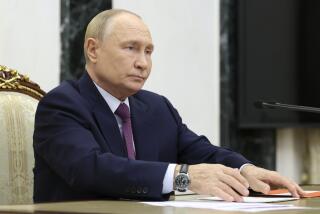U.S. Tells NATO It Won’t Ban Battlefield A-Weapons
- Share via
WASHINGTON — The Reagan Administration, hoping to reassure nervous NATO allies, said Monday that it will not consider a ban on battlefield nuclear weapons, even if the United States and the Soviet Union agree to eliminate intermediate-range nuclear forces from Europe.
State Department spokesman Charles Redman reaffirmed American support for the North Atlantic Treaty Organization’s decades-old doctrine of “flexible response,” which envisions the use of conventional weapons, battlefield nuclear arms and--as a last resort--continent-spanning strategic missiles to respond to a Soviet conventional attack.
Redman, responding to a tentative offer by Soviet spokesmen over the weekend, drew a sharp distinction between tactical or battlefield nuclear weapons with a range of less than 350 miles and the intermediate nuclear forces, ranging from 350 to 3,000 miles, that Soviet leader Mikhail S. Gorbachev has suggested prohibiting in Europe. President Reagan reacted favorably to Gorbachev’s proposal, although the Administration has said it will confer with its European allies before drafting its response.
European members of NATO have expressed concern that removal of nuclear weapons would expose them to the superior conventional forces of the Soviet-led Warsaw Pact. Although NATO is on record in support of eliminating longer-range intermediate nuclear weapons--with a range of between 1,000 and 3,000 miles--from the Continent, it opposes a total ban on nuclear weapons in Europe.
During Secretary of State George P. Shultz’s visit to Moscow last week, he and Soviet negotiators agreed in principle to eliminate the longer-range intermediate missiles from Europe over a four- or five-year period.
“Our doctrine of flexible response is based on three legs--conventional, tactical nuclear and strategic nuclear,” Redman said Monday. “All three legs will continue to be intact, regardless of what decisions we come to on the question of (intermediate nuclear forces). . . . Short-range (battlefield) nuclear forces are not on the table, are not being discussed.
“The reason the tactical nuclear component is important is . . . disparity in terms of conventional capabilities, in terms of chemical capabilities.”
Asked if he was ruling out negotiations on tactical nuclear weapons, Redman said that such talks might be possible but only if overall U.S.-Soviet relations improve dramatically.
“We would have to look at other aspects of Soviet behavior; for example, in such areas as Afghanistan and Cambodia,” he said.
NATO’s “high-level group,” a nuclear policy subcommittee, is scheduled to meet Wednesday and Thursday at Kirtland Air Force Base in Albuquerque, N.M. Another NATO nuclear policy subcommittee, the Special Consultative Group, will meet April 28 in Brussels. Gorbachev’s proposal will be on the agenda of both meetings.
NATO voted in 1979 to deploy U.S. Pershing 2 and cruise missiles in Europe to counter Soviet SS-20 missiles. Later, NATO endorsed Reagan’s “zero-zero option,” which called for elimination of longer-range intermediate nuclear forces. The Soviets were unresponsive at first, but later Gorbachev accepted the Reagan plan and proposed extending it to other classes of weapons.
Reagan and Gorbachev agreed in principle last year in Iceland that both countries would remove longer-range intermediate nuclear forces from Europe. During Shultz’s visit to Moscow, Gorbachev proposed extending the ban to shorter-range intermediate nuclear forces.
When Soviet spokesmen suggested on American television talk shows during the weekend that Moscow was ready to begin talks about banning tactical weapons as well, the Administration decided to make it clear that Washington was not prepared to go that far.
More to Read
Get the L.A. Times Politics newsletter
Deeply reported insights into legislation, politics and policy from Sacramento, Washington and beyond. In your inbox twice per week.
You may occasionally receive promotional content from the Los Angeles Times.










